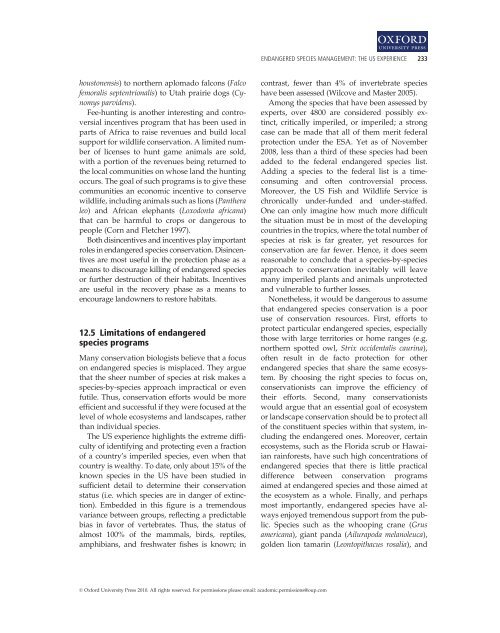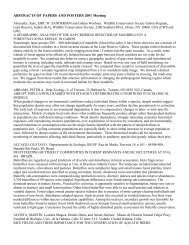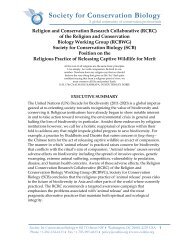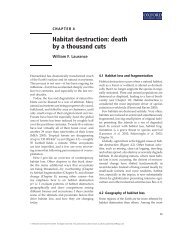Endangered species management: the US experience - Society for ...
Endangered species management: the US experience - Society for ...
Endangered species management: the US experience - Society for ...
Create successful ePaper yourself
Turn your PDF publications into a flip-book with our unique Google optimized e-Paper software.
1<br />
ENDANGERED SPECIES MANAGEMENT: THE <strong>US</strong> EXPERIENCE 233<br />
houstonensis) to nor<strong>the</strong>rn aplomado falcons (Falco<br />
femoralis septentrionalis) to Utah prairie dogs (Cynomys<br />
parvidens).<br />
Fee-hunting is ano<strong>the</strong>r interesting and controversial<br />
incentives program that has been used in<br />
parts of Africa to raise revenues and build local<br />
support <strong>for</strong> wildlife conservation. A limited number<br />
of licenses to hunt game animals are sold,<br />
with a portion of <strong>the</strong> revenues being returned to<br />
<strong>the</strong> local communities on whose land <strong>the</strong> hunting<br />
occurs. The goal of such programs is to give <strong>the</strong>se<br />
communities an economic incentive to conserve<br />
wildlife, including animals such as lions (Pan<strong>the</strong>ra<br />
leo) and African elephants (Loxodonta africana)<br />
that can be harmful to crops or dangerous to<br />
people (Corn and Fletcher 1997).<br />
Both disincentives and incentives play important<br />
roles in endangered <strong>species</strong> conservation. Disincentives<br />
are most useful in <strong>the</strong> protection phase as a<br />
means to discourage killing of endangered <strong>species</strong><br />
or fur<strong>the</strong>r destruction of <strong>the</strong>ir habitats. Incentives<br />
are useful in <strong>the</strong> recovery phase as a means to<br />
encourage landowners to restore habitats.<br />
12.5 Limitations of endangered<br />
<strong>species</strong> programs<br />
Many conservation biologists believe that a focus<br />
on endangered <strong>species</strong> is misplaced. They argue<br />
that <strong>the</strong> sheer number of <strong>species</strong> at risk makes a<br />
<strong>species</strong>-by-<strong>species</strong> approach impractical or even<br />
futile. Thus, conservation ef<strong>for</strong>ts would be more<br />
efficient and successful if <strong>the</strong>y were focused at <strong>the</strong><br />
level of whole ecosystems and landscapes, ra<strong>the</strong>r<br />
than individual <strong>species</strong>.<br />
The <strong>US</strong> <strong>experience</strong> highlights <strong>the</strong> extreme difficulty<br />
of identifying and protecting even a fraction<br />
of a country’s imperiled <strong>species</strong>, even when that<br />
country is wealthy. To date, only about 15% of <strong>the</strong><br />
known <strong>species</strong> in <strong>the</strong> <strong>US</strong> have been studied in<br />
sufficient detail to determine <strong>the</strong>ir conservation<br />
status (i.e. which <strong>species</strong> are in danger of extinction).<br />
Embedded in this figure is a tremendous<br />
variance between groups, reflecting a predictable<br />
bias in favor of vertebrates. Thus, <strong>the</strong> status of<br />
almost 100% of <strong>the</strong> mammals, birds, reptiles,<br />
amphibians, and freshwater fishes is known; in<br />
contrast, fewer than 4% of invertebrate <strong>species</strong><br />
have been assessed (Wilcove and Master 2005).<br />
Among <strong>the</strong> <strong>species</strong> that have been assessed by<br />
experts, over 4800 are considered possibly extinct,<br />
critically imperiled, or imperiled; a strong<br />
case can be made that all of <strong>the</strong>m merit federal<br />
protection under <strong>the</strong> ESA. Yet as of November<br />
2008, less than a third of <strong>the</strong>se <strong>species</strong> had been<br />
added to <strong>the</strong> federal endangered <strong>species</strong> list.<br />
Adding a <strong>species</strong> to <strong>the</strong> federal list is a timeconsuming<br />
and often controversial process.<br />
Moreover, <strong>the</strong> <strong>US</strong> Fish and Wildlife Service is<br />
chronically under-funded and under-staffed.<br />
One can only imagine how much more difficult<br />
<strong>the</strong> situation must be in most of <strong>the</strong> developing<br />
countries in <strong>the</strong> tropics, where <strong>the</strong> total number of<br />
<strong>species</strong> at risk is far greater, yet resources <strong>for</strong><br />
conservation are far fewer. Hence, it does seem<br />
reasonable to conclude that a <strong>species</strong>-by-<strong>species</strong><br />
approach to conservation inevitably will leave<br />
many imperiled plants and animals unprotected<br />
and vulnerable to fur<strong>the</strong>r losses.<br />
None<strong>the</strong>less, it would be dangerous to assume<br />
that endangered <strong>species</strong> conservation is a poor<br />
use of conservation resources. First, ef<strong>for</strong>ts to<br />
protect particular endangered <strong>species</strong>, especially<br />
those with large territories or home ranges (e.g.<br />
nor<strong>the</strong>rn spotted owl, Strix occidentalis caurina),<br />
often result in de facto protection <strong>for</strong> o<strong>the</strong>r<br />
endangered <strong>species</strong> that share <strong>the</strong> same ecosystem.<br />
By choosing <strong>the</strong> right <strong>species</strong> to focus on,<br />
conservationists can improve <strong>the</strong> efficiency of<br />
<strong>the</strong>ir ef<strong>for</strong>ts. Second, many conservationists<br />
would argue that an essential goal of ecosystem<br />
or landscape conservation should be to protect all<br />
of <strong>the</strong> constituent <strong>species</strong> within that system, including<br />
<strong>the</strong> endangered ones. Moreover, certain<br />
ecosystems, such as <strong>the</strong> Florida scrub or Hawaiian<br />
rain<strong>for</strong>ests, have such high concentrations of<br />
endangered <strong>species</strong> that <strong>the</strong>re is little practical<br />
difference between conservation programs<br />
aimed at endangered <strong>species</strong> and those aimed at<br />
<strong>the</strong> ecosystem as a whole. Finally, and perhaps<br />
most importantly, endangered <strong>species</strong> have always<br />
enjoyed tremendous support from <strong>the</strong> public.<br />
Species such as <strong>the</strong> whooping crane (Grus<br />
americana), giant panda (Ailurapoda melanoleuca),<br />
golden lion tamarin (Leontopithacus rosalia), and<br />
© Ox<strong>for</strong>d University Press 2010. All rights reserved. For permissions please email: academic.permissions@oup.com






